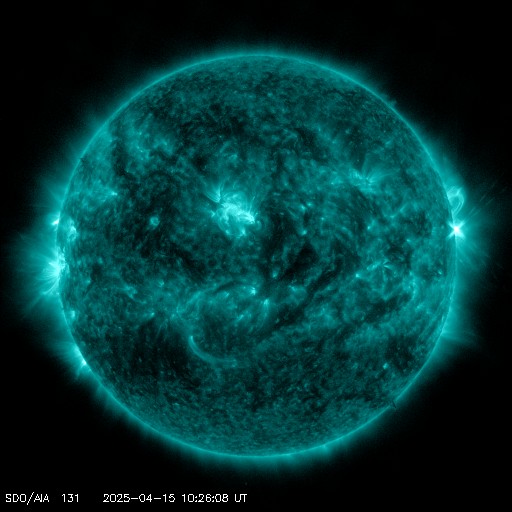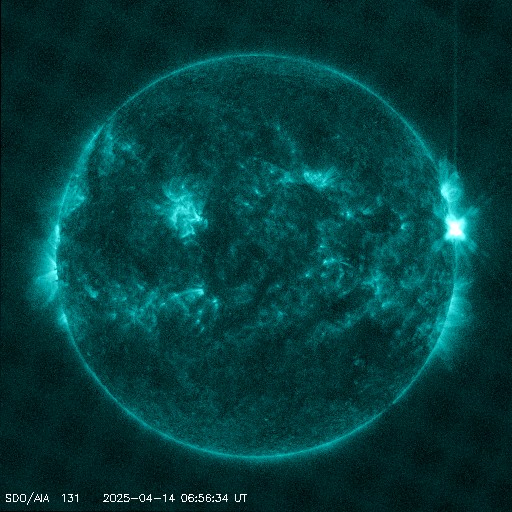Viewing archive of Thursday, 15 May 2003
Solar activity report
Any mentioned solar flare in this report has a scaling factor applied by the Space Weather Prediction Center (SWPC). Because of the SWPC scaling factor, solar flares are reported as 42% smaller than for the science quality data. The scaling factor has been removed from our archived solar flare data to reflect the true physical units.
Report of Solar-Geophysical Activity 2003 May 15 2200 UTCPrepared by the NOAA © SWPC and processed by SpaceWeatherLive.com
Joint USAF/NOAA Report of Solar and Geophysical Activity
SDF Number 135 Issued at 2200Z on 15 May 2003IA. Analysis of Solar Active Regions and Activity from 14-2100Z to 15-2100Z
Solar activity has been low. Two new regions were
numbered today: Region 361 (N09E39) and Region 362 (S10E77).
IB. Solar Activity Forecast
Solar activity is expected to be very
low, with possible increase in activity over the next few days due
to active regions emerging from the east limb. New region 362 may
produce isolated flare activity.
IIA. Geophysical Activity Summary 14-2100Z to 15-2100Z
The geomagnetic field has been at unsettled to minor storm levels due
to a high speed solar wind stream from a favorably positioned
coronal hole. The greater than 2 MeV electron flux at
geosynchronous orbit reached high levels today.
IIB. Geophysical Activity Forecast
The geomagnetic field is
expected to be at unsettled to active levels for the next three
days. Solar wind speeds should continue to reduce over the next few
days, and may cause isolated minor storm levels on day one.
III. Event Probabilities 16 May to 18 May
| Class M | 10% | 15% | 20% |
| Class X | 01% | 01% | 01% |
| Proton | 01% | 01% | 01% |
| PCAF | green | ||
IV. Penticton 10.7 cm Flux
Observed 15 May 099 Predicted 16 May-18 May 105/110/120 90 Day Mean 15 May 123
V. Geomagnetic A Indices
Observed Afr/Ap 14 May 017/027 Estimated Afr/Ap 15 May 015/022 Predicted Afr/Ap 16 May-18 May 010/015-010/015-015/015
VI. Geomagnetic Activity Probabilities 16 May to 18 May
| A. Middle Latitudes | |||
|---|---|---|---|
| Active | 25% | 25% | 25% |
| Minor storm | 15% | 10% | 10% |
| Major-severe storm | 05% | 01% | 01% |
| B. High Latitudes | |||
|---|---|---|---|
| Active | 35% | 35% | 35% |
| Minor storm | 15% | 15% | 15% |
| Major-severe storm | 05% | 05% | 05% |
All times in UTC
Current data suggests there is a slight possibility for aurora to appear at the following high latitude regions in the near future
Fairbanks, AKLatest news
Latest forum messages
Incoming & Unnumbered Active Regions 1709Potential AR4062 10Ask your obscure/"stupid" space weather questions. 3552025/04/12-13 Filament CMEs 2025/04/16 G2 Watch 56Filaments and prominences 62
More topicsSupport SpaceWeatherLive.com!
A lot of people come to SpaceWeatherLive to follow the Sun's activity or if there is aurora to be seen, but with more traffic comes higher server costs. Consider a donation if you enjoy SpaceWeatherLive so we can keep the website online!

Latest alerts
10:39 UTC - Solar flare
Moderate M1.52 flare from sunspot region 4055
10:24 UTC - Radio Blackout
Minor R1 radio blackout in progress (≥M1 - current: M1.52)
Monday, 14 April 2025
23:15 UTC - Geomagnetic activity
Active geomagnetic conditions (Kp4) Threshold Reached: 23:01 UTC
07:09 UTC - Solar flare
Moderate M4.28 flare from sunspot region 4055
06:48 UTC - Radio Blackout
Minor R1 radio blackout in progress (≥M1 - current: M1.53)
Space weather facts
| Last X-flare | 2025/03/28 | X1.1 |
| Last M-flare | 2025/04/14 | M4.2 |
| Last geomagnetic storm | 2025/04/06 | Kp5 (G1) |
| Spotless days | |
|---|---|
| Last spotless day | 2022/06/08 |
| Monthly mean Sunspot Number | |
|---|---|
| March 2025 | 134.2 -20.4 |
| April 2025 | 128.8 -5.4 |
| Last 30 days | 129.1 -15.1 |





